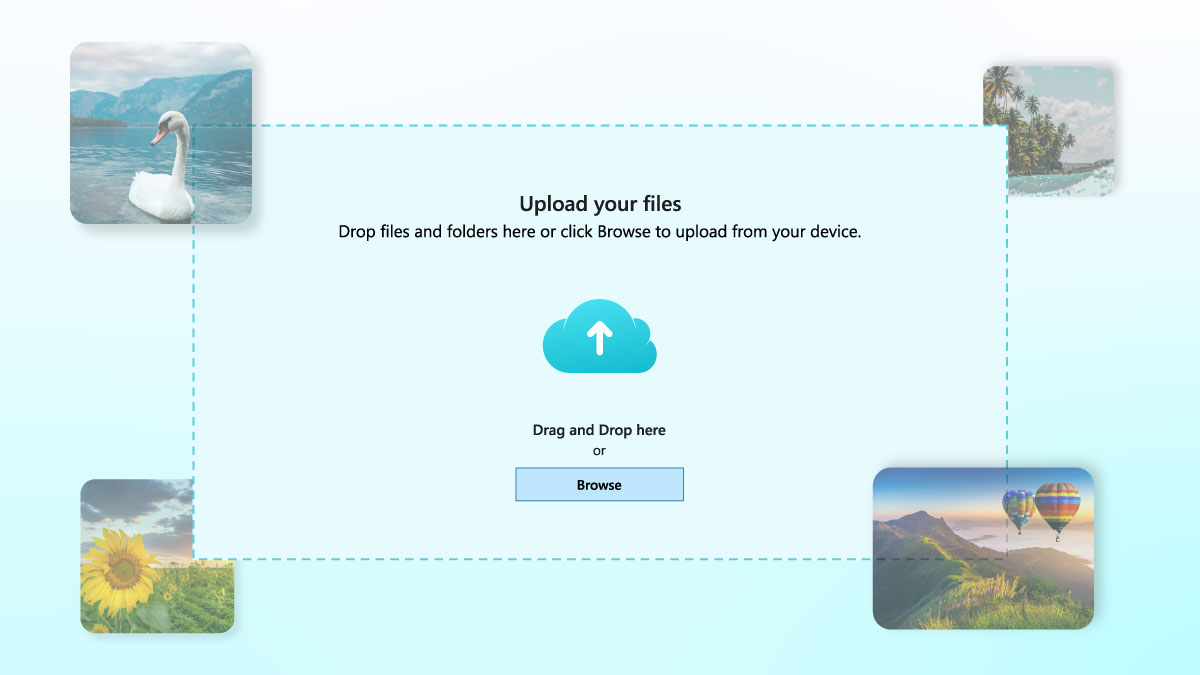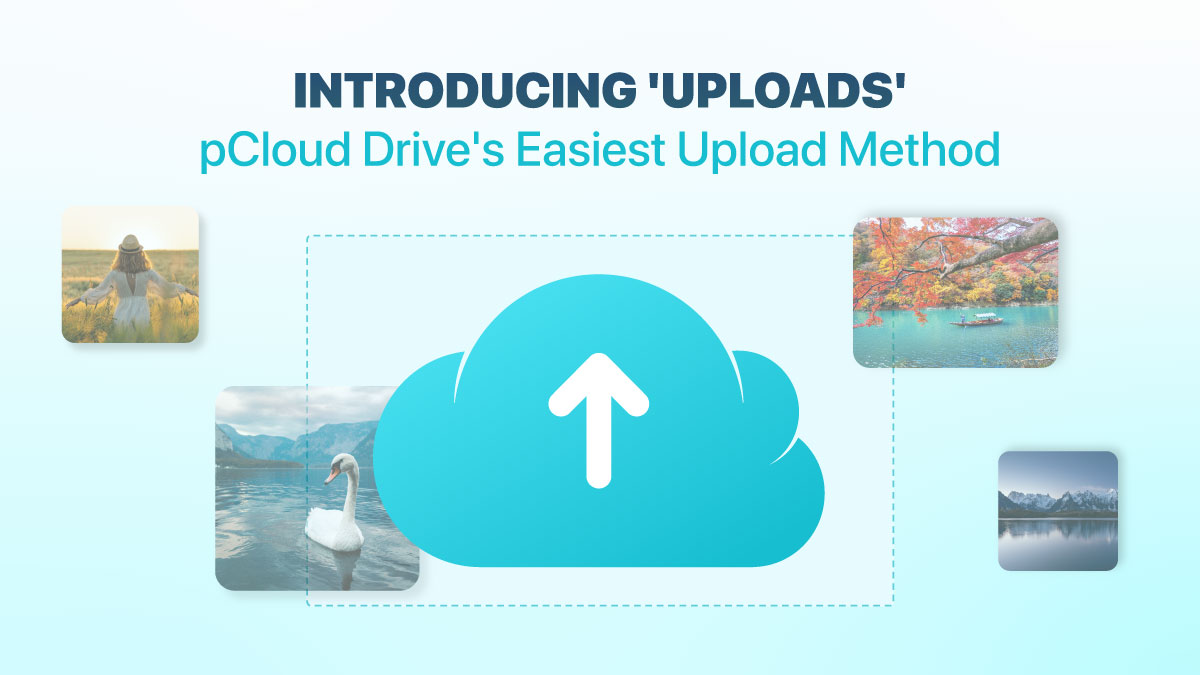Introducing ‘Uploads’ – pCloud Drive’s Easiest Upload Method
Welcome our newest quick and stable uploading feature and forget about local disk full issues at the same time!
‘Uploads’ feature — what problem does it solve?
In our continuous effort to improve the pCloud Drive experience across macOS, Linux, and Windows, we’re excited to introduce our latest feature — Uploads. Designed with user satisfaction in mind, ‘Uploads’ promises a seamless, efficient, and reliable way to easily upload your local files and folders to pCloud.
Currently, manual uploads (copy-paste or drag-drop) to pCloud Drive in File Explorer or Finder directly, use your local disk space to cache the files, waiting to get uploaded on pCloud. Cache usage ensures a stable upload process this way, especially when it comes to large data sets. However, if your local disk fails to handle the cache, your uploads will fail anyway. This is a huge issue when you attempt to upload many files and folders at once, or you lack free space on your machine to handle that cache. On the other hand, our Backup and Sync features do not use any local disk space for caching, but they are not that suitable if you simply want to drop your files for a single one-way transfer only.
Therefore, we figured that the most suitable solution for what you needed is to provide an easy one-way upload method by ensuring the uploads are stable and without using the local disk space for caching.
And here we go, with our newest ‘Uploads’ feature we resolve all of that and provide an easy and stable upload, without flooding your local machine space with any cache at all!
pCloud’s ‘Uploads’ feature may also work as a one-way backup for you. You simply must use it regularly to upload the changed versions of your files to the exact same directory used the last time for them on pCloud. This will overwrite the changes to the cloud quickly and ensure that your local copies will always be saved to the cloud, which on the other hand keeps all your file versions back in time, depending on your account history. By circumventing local cache storage issues and ensuring uploads resume after outages, ‘Uploads’ guarantees a smooth and stable upload process. Large files or entire directories can now be uploaded directly from your local or external storage devices without a hitch.
How does ‘Uploads’ work?

It’s quite easy! The feature is a part of our desktop app pCloud Drive — you just have to open its menu and drag-drop your files or folders into the ‘Uploads’ tab there. You can also choose the option to ‘Upload to pCloud’ upon right-clicking on your local files and folders as soon as you start pCloud Drive.
Note: Linux users do not yet have the possibility to use drag and drop or context menu options to local files and folders, so they can currently use the ‘Browse’ option via ‘Uploads’ in the general user interface of the app only.
You will see a progress bar, which indicates what happens with the number of items dropped which gives you a better idea of what happens at the time of the upload — pCloud Drive gets paused, your Internet connection failed or maybe you have just moved a folder that included these files and the upload failed for some items. Another great thing about ‘Uploads’ is that there are no limits on the number of files or folders or on their size. You should simply note that uploading larger files and heavier folder structures might take more time for the process to be finished, which is dependent on your current internet speed as well.
Bear in mind that you are not able to upload in folders of pCloud which are a part of an ongoing Sync, or the Crypto folder. Synced directories might cause a never-ending loop so they will be excluded by default, whereas the Crypto folder does not allow this type of upload to be used to it due to its specific type of encryption. The technology that we use behind ‘Uploads’ is like the one that we are using in the Sync feature, therefore these limitations were necessary for the better usage of it.
What are the good practices when using ‘Uploads’?

In general, ‘Uploads’ simplifies and resolves many issues that other pCloud Drive features could not easily address. Like any new feature, ‘Uploads’ has its unique functionality, which we aim to clarify to enhance your understanding and preparedness. Below, we outline best practices for using ‘Uploads’ to ensure a seamless user experience. If you are uploading to а folder, in which you got invited or you have invited other people to, make sure that the permission for access to Edit the folder is set up while the upload is ongoing, if you want to ensure that all the people with access to that folder would be able to use the space properly. Another thing that you should consider when using ‘Uploads’ is not to move any of the folders that you are currently uploading or any of the folders in pCloud used as a destination for the transfer.
It is good to remember that if you are using this feature with a non-local directory (e.g. external drives, CDs, etc.), you must make sure that the external device remains connected to the machine until the upload process initiated gets completed. Ejecting the external device during an upload process will terminate the process. Logically enough, unmounting pCloud Drive will also terminate the process in ‘Uploads’.
Renaming a file that has been added for uploading is also something that we do not advise you to do unless you want it to get uploaded with that new name to the cloud.
Uploading a file with the same name but with different content than the file in the destination, pCloud’s folder is something to be very aware of prior to initiating any upload process. Since, as mentioned earlier in this article, ‘Uploads’ uses the same backend technology that we have for our ‘Sync’ feature, what would happen if you uploaded a file with the same name but different content, is that the file with the same name would overwrite its new content to the file that already exists on the cloud. This could be considered a plus if you want to overwrite a new version to the file with the same name, however, if that is not your intention – check what names you have for the files in the chosen destination folder prior to dropping the files in ‘Uploads’.
Why ‘Uploads’?
This feature is not just about uploading files – it’s about providing a reliable, efficient way to secure your data on the cloud without worrying about local device limits. The elimination of local cache usage means a higher success rate for your uploads, and with the ability to handle large datasets, ‘Uploads’ is perfect for both personal and professional use. The fact that it is working as a one-way backup for your files if you regularly upload to the same directory on the cloud, can make sure that you will always have your versions kept on the cloud, especially if you possess an Extended File History subscription to extend that time.
You are also able to exclude file types or names of folders from the upload process via our ‘Exclusion’ list, located in the ‘Settings’ of our desktop app, which is making the upload even more manageable when it comes to uploading large set of files and folders. It does not matter whether you will pause pCloud Drive, the internet connection will fail or your machine would get shut down – ‘Uploads’ will continue uploading where it has been left off as soon as the connection is up again. This makes ‘Uploads’ quite more stable than a regular manual upload directly in Finder or File explorer apps to pCloud or even using our web interface for uploading.
In conclusion, ‘Uploads’ by pCloud Drive is more than a feature; it’s your peace of mind in the digital age. Start backing up your important files today and experience a cloud storage solution that truly cares about your data!
